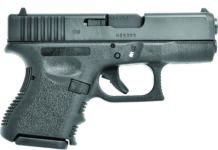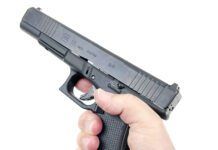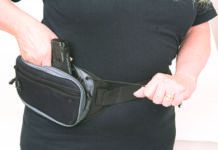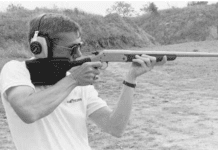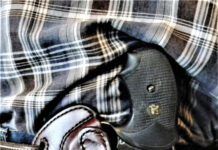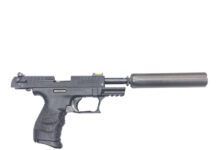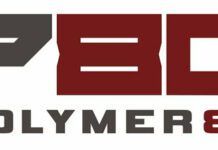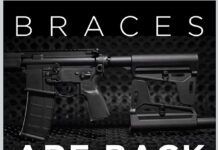It is reasonable to expect that any pistol-evaluation piece covering “options in self defense” would focus on a range of semi-automatics that combine power with portability. For this test, we chose the $1059 Kimber Stainless Target .38 Super, Heckler & Kochs $879 P2000 V3 .40 S&W, and a Sigarms factory certified pre-owned P226, which came with both .40 S&W and .357 Sig barrels, $699.
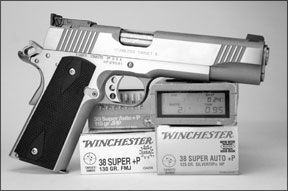
We thought the use of the word “options” was suitable because each of our guns was distinctly different in both construction and operation:
The Kimber Stainless Target is a full-size 1911 built on a stainless-steel frame. The single-action trigger requires only a short press for ignition.
The HK P2000 V3 is a polymer-framed weapon with both double- and single-action trigger pull. A unique feature was the placement of the decocker on the rear of the slide. Furthermore, the P2000 offered interchangeable backstraps in an attempt to customize the grip.
The Sigarms P226 utilized a stainless-steel slide and an aluminum frame. The trigger system also featured both a double- and single-action pull, but the decocker was mounted on the frame. And, as mentioned above, the gun was shipped with two different barrels for firing both the .40 S&W and .357 Sig rounds.
How We Tested
Our test distance from the sandbag rests was 25 yards. In addition, we tested the guns in a rapid-fire sequence at close range. From a distance of 5 yards we fired freestyle holding the guns in both hands. We also performed strings using just the strong hand.
Our test procedure was five attempts at two shots to center mass designated by a sheet of loose-leaf paper measuring 8.5 by 11 inches. Elapsed time for each string of fire was recorded, as well as the elapsed time between the first and second shot. This was referred to as the split time, or “split.”
Would we be able to shoot the guns fast and accurately? Here is what we learned.
Sigarms P226 .40 S&W/.357 Sig, $699
The price for our P226 was $699, but according to Sigarms, actual pricing of certified pre-owned guns are left to the distributor. Availability of such models is limited, but here is what we bought.
The P226 was built on the Sigarms full-size frame. It had a 4.4-inch barrel fed from 12-round magazines capped with a flat base pad that did not lengthen or change the profile of the grip. All controls, such as the slide release, decocker, slide latch, and magazine release, were located on the left side of the frame. But the magazine release button may be moved to the opposite side.
The stainless-steel slide was manufactured at the Sigarms plant in Exeter, New Hampshire, and the alloy receiver was produced in Germany. The grip was plastic, and we thought this design did an excellent job of streamlining the pistol. Sigarms does offer upgraded models that feature rounded edges at every point, but the basic P-series design is already more “snag-free” than the majority of pistols sold over the counter.
Sigarms proprietary Contrast sights were in place, featuring a white dot up front and a white vertical line marking the center of the rear notch. Two stainless-steel barrels were supplied. The .357 Sig barrel weighed slightly more than the .40 S&W barrel because less material was removed from the original blank to create the .357 Sig chamber and the smaller diameter bore. No malfunctions of any kind were experienced firing either round.
The heart of the P226 was the traditional double-action trigger. The P226 was designed to be carried with the chamber loaded and hammer down for a first shot double-action, which both raised and released the hammer. Once the slide was moved to the rear for the first shot, the hammer was left cocked and ready for release via a shorter movement of the trigger requiring less force. We measured double-action resistance to be 11 pounds versus 5.5 pounds of resistance to break the single-action trigger. The TDA system does not include a true manual safety that locks the action or disconnects the trigger. Instead, using the decocker meant that the first shot double-action trigger required a much longer stroke against greater resistance. This was designed to prevent an unintentional discharge that is much more likely once the hammer is back.
This also speaks to safely holstering the pistol. Ideally, holstering should be done without looking at the gun or the holster as the eyes should be searching for the next threat. The strong-hand thumb should be placed on the rear face of the slide when holstering a TDA gun to make sure that friction produced by
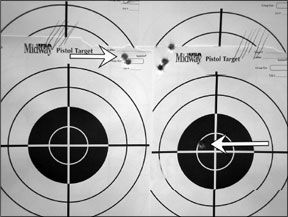
pushing the gun into the holster does not move the slide out of battery. This is because TDA guns do not have a safety that prevents the slide from moving. With the thumb behind the slide, the position of the hammer should also become obvious. If the hammer is back, the operator needs to press the decocker. We think that being able to feel and see the hammer and determine the ready condition of the pistol makes this type of gun safer to operate.
Our staff found that the ergonomics of the P226 were favorable for shooting in transition from double to single action. The 3-inch trigger span for the first shot DA placed the pad of the index finger on the center of the trigger. Reset to the 2.7-inch SA trigger span was comfortable for most shooters. The key here was to utilize a similar length stroke for both DA and SA fire.
The Sigarms P226 did not come with alternate grips or grip panels to change trigger span or the way it filled the shooters hands. But alternate parts to adapt the P226 to a wider range of shooters are available aftermarket. Sigarms does sell a short trigger, which substantially shortens the distance to the face of the trigger. But we found this was useful only for those with very small hands. Average to larger size hands will find the short trigger helpful in commanding the double-action press, but once the trigger resets to the single-action position the point of contact was too far back-in most cases positioned even as far back as the second joint of the finger.
Another alternative is installation of the TJs Custom Sig trigger, $70 from Brownells, (800) 741-0015. This trigger was inspired by a popular revolver modification used by PPC competitors. The TJs trigger was rounded and thin. The purpose of this design was to let the finger roll smoothly and evenly across the trigger. Grip alternatives, such as hard-rubber replacement stocks from Hogue, can also reduce the circumference of the grip ($24, with or without finger grooves from getgrip.com). Fancy checkered aluminum grips by Hogue, $130 to $160, are also available.
At the range we learned that there was indeed a difference in the performance of our P226 when we changed barrels. Our first round of tests was performed with the .357 Sig barrel in place. The average measurement of our five-shot groups was 2.1 inches firing both 125-grain rounds from Winchester and Speer respectively. The 140-grain Sellier & Bellot ammunition (manufactured in Czech Republic) produced an average five-shot group measuring 2.9 inches across. Results firing the .40 S&W ammunition produced average groups measuring 3.1 inches across for both the Winchester 165-grain FMJ rounds and the Black Hills 180-grain JHP loads.
Point of impact firing the .357 Sig ammunition matched point of aim, but the point of impact with the .40 S&W barrel in place was about 6 inches high. This tells us that changing barrels should also include changing the front sight to adjust point of impact. Furthermore, we noticed that when we loaded a magazine into the gun and hand cycled the action to chamber a round, our groups printed one hit substantially lower than the others. When we fired a round downrange and let the force of ignition cycle the slide, our groups were tighter. But we still suffered a flyer about once every seven shots.
The results of our action test underscored the difference in recoil behavior between the two calibers. The .40 S&W rounds introduced more muzzle flip and torque than the .357 Sig rounds. With the lights down low at Top Gun of Houston (topgunrange.com), the flash from the .357 Sig was significant. Muzzle flash was detrimental to the shooters vision when point shooting or looking over the top of the gun while firing. However, we found that the flash was not as apparent to the shooter when focus was concentrated on the front sight.
We began our action tests firing with the gun held in both hands. Loading the gun with the .40 ammo, we averaged a total elapsed time of 1.22 seconds, with an average split time of 0.37 seconds from shot to shot. Firing the .357 Sig rounds in this same manner, the average total elapsed time was 1.20 seconds with an average interval of 0.39 seconds between shots. In each case all ten shots were on the paper.
Firing strong hand only, the .357 Sig strings were slightly faster on average. It took us 1.41 seconds with a 0.52-second split versus 1.47/0.54 seconds for the .40. But we only dropped one shot with the .40 and three firing the .357 rounds. We blamed our operator for firing faster than he could control the sights.
However, this test was performed firing the respective FMJ selections of our test rounds, of which the .357 Sig ammunition was much more powerful. Perhaps we should have used the more powerful 165-grain Speer Gold Dot ammunition for the .40 portion of the test. This might have equalized the amount of recoil from each caliber and made for a better comparison. But we dont think this would have changed our final analysis regarding choice of barrel or caliber.
If you are strictly looking for power, the .357 Sig rounds we tested each presented approximately 500 ft.-lbs. of muzzle energy. The fact is that we havent been able to find any .357 Sig ammunition that could be considered a reduced-power practice load at an economical price. If you are interested in economy and versatility, the available selection of .40 S&W ammunition is much greater and the cost much less.
Heckler & Koch P2000 V3
.40 S&W, $879
The P2000 V3 represented the polymer-framed option in this test. The P2000 V3 offered 12+1 capacity in a more compact body than
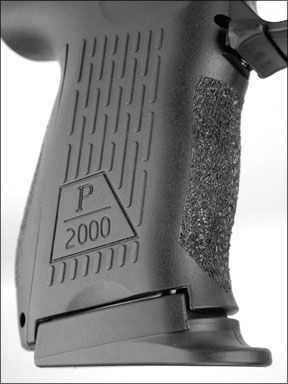
our other test pistols, with features that are unique to Heckler & Koch.
The magazine release was ambidextrous and could be operated by the thumb, the middle finger, or the index finger of the strong hand. The top end accounted for nearly all of the pistols weight. One reason for this was that the bulk of the locking and unlocking assembly was carried on the end of the guide rod, which included a captured spring and a shock buff. The top of the block attached to the guide rod interacted with the barrel during cycling, and a notch on the bottom of the block anchored it to the frame. Removing the top end was as simple as lining up the relief in the slide with the release lever and pushing out the cross pin from the left side. A matching slide-release lever found on the right side stayed with the frame.
We weighed the P2000 V3 without the magazine in place to be 24.1 ounces. But we think it is important to note its 27.2-ounce total weight with the magazine in place because the base pad added significantly to the grip. The front of the slide and frame were steeply beveled to aid holstering, and new for HK, the dustcover was sculpted with a Picatinny accessory rail. Previous models featured a rail of less universal dimensions and not a single cross hatch.
The front strap and the rear surface of the grip was finished with stippling, which proved effective. The sides of the grip were flat, which helped thin its profile. Another common HK feature was the indentation at the base of the side panels that are helpful should the magazine become stuck and need to be ripped from the receiver. But we suffered no malfunctions of any kind during our tests.
Our P2000 V3 operated with the TDA style first shot double-action trigger with decocker mounted on the rear face of the slide. This is an excellent answer, in our view, to decocking and holstering the gun in one quick movement. For example, after the first shot was fired double action, the hammer remained back ready for a single-action release. But once the fight was over, the thumb was moved to the rear of the slide to prevent it from being knocked out of battery as it reached the mouth of the holster. At the same time the hammer can be decocked. The P2000 can also be decocked while keeping the muzzle in the direction of a threat by using the thumb of the weak hand. Trigger resistance was measured to be about 6 pounds single action and 12 pounds double action.
The back of the receiver was covered by a panel held in place by a single roll pin at the butt of the grip. Underneath the rear panel was the hammer strut and mainspring. With the rear panel removed, the mainspring was free to slide off but the hammer strut stayed in place. The P2000 came with four different panels for the back strap. The trigger span (the distance from the face of the trigger rearward) did not change very much with each panel. But the way each panel served to fill the hand was remarkably different despite two of the panels offering the same maximum circumference.
From the bench we shot the P2000 single action only with the smallest back strap in place. The results with both the Winchester 165-grain FMJ ammunition and the Black Hills 180-grain hollowpoints produced groups that measured about 1.8 inches across. This was the best overall performance of our three guns. But firing the 165-grain Speer Gold Dot plus P ammunition all of our groups measured in excess of three inches across. We think this was a control issue. Generating almost 480 ft.-lbs. of muzzle energy with velocity above 1140 fps on average, the Gold Dots produced more recoil. We could feel the slide moving faster and more violently. The heavier, slower-moving 180-grain hollowpoints were a better choice for this gun, in our view.
It was during our action test that we learned how to choose the proper back strap. We began with the smallest panel in place. Firing free style we landed all of our shots in the desired zone. Average elapsed time was 1.20 seconds with a split time of 0.39 seconds. We repeated this drill strong hand only and recorded an average elapsed time of 1.41 seconds with a 0.52-second split. But three shots were off target. We needed help keeping the gun balanced throughout the transition from double- to single-action fire. This led us to try the other backstraps.
Our test shooter settled on the panel with the large palm swell marked “L” and tried again. This time all our shots were on target. Elapsed time was comparable to our first attempt, averaging 1.47 seconds with an average split time of 0.57 seconds. The lesson here was to choose the panel that helps you achieve the most consistent accuracy from the off hand position.
Kimber Stainless Target
Polished .38 Super, $1059
The Kimber Stainless Target .38 Super is a Browning 1911 pistol that feeds nine rounds of .38 Super Automatic (+P) from a single-column magazine. It could be easily confused with a .45 ACP model if it werent for the smaller hole in the barrel.
Our Kimber had a subtle contrasting finish. The top of the slide, the underside of the dustcover, the front strap and the surface along the mainspring housing were a frosted matte finish. The sides of the slide and the upper frame were polished. The grip panels were black rubber with a checkered pattern held in place by Allen screws.
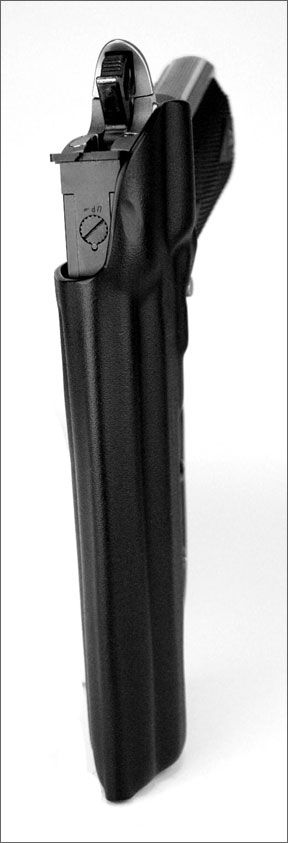
The thumb safety was left side only. Upgraded components such as an aluminum trigger, extended beavertail grip safety, relieved hammer, checkered mainspring housing, cocking serrations on the slide fore and aft, and a full-length guide rod were in place.
The front sight was a plain target blade devoid of any dots or tritium. The rear unit was a fully adjustable Bo-Mar design. Lockup at the muzzle included a barrel bushing. We could make out a slight increase in the diameter of the barrel starting about 0.3 inches from the muzzle.
We have in the past tested 1911s chambered for calibers other than .45 ACP, such as 9mm and .40 S&W. In terms of reliability, the results have been mixed. But the Kimber Stainless Target .38 Super ran without any problems throughout our tests. This should be of no surprise because chambering the Browning/Colt 1911 for .38 Super goes back to 1929. What the 1911 chambered in .38 Super brings to the table is less recoil and higher capacity than .45 ACP models. Other advantages include a passive action grip safety and a mechanical safety that literally turns the gun on or off. Furthermore, the narrow profile of the 1911 helped the gun point cleanly and conceal easily despite its weight.
In terms of training the 1911 offers one additional advantage. Since the trigger does not change in operation from shot to shot, a dry-fire regimen can be utilized to refine technique.
One negative aspect of chambering the 1911 for .38 Super was how it affected the ability of the shooter to perform a quick reload. The overall profile of .45 ACP ammunition is short, tapered, and round at the tip. The .38 Super rounds lend a thin, boxy profile to the top of a loaded magazine. This made quick reloads that much more difficult. The magazine well of our Kimber was beveled on the sides, but we would add a magazine guide such as the Wilson Combat Custom magazine well. This $30 part from wilsoncombat.com bolted on via the grip screws to add a funnel-like profile to the magazine well without modification to the frame.
Kimber also offers pistols chambered for .38 Super in a Commander-sized package with a shorter barrel and slide. But in this case we chose to maximize its power by providing a longer barrel from which to generate velocity. This enabled us to edge out our other test pistols by generating average muzzle energy of 525 ft.-lbs. when loaded with Cor-Bons 115-grain JHP rounds. Accuracy from the bench at 25 yards averaged about 2.25 inches for all shots fired. Our most accurate performance was turned in by the Winchester Silvertip HP ammunition, but we found little variation in accuracy between brands. In terms of selection, there is not a variety of ammunition to choose from in this caliber. But no matter what we loaded, the Kimber Stainless Target was easy to shoot.
Our action test firing the Kimber .38 Super was very different than our drills with the Sigarms and HK pistols. This was because we had only one trigger to deal with. Presenting just less than 5 pounds of resistance, the action was clean, smooth, and predictable. Beginning with the safety on and firing with both hands on the gun, our runs were very consistent. Average elapsed time was 0.96 seconds with an average of 0.26 seconds between shots. Variation in total elapsed time was only 0.06 seconds, and all shots were on target. Firing strong hand only, our elapsed time was 1.30 seconds with a 0.44-second split. But we landed three shots off target. We were able to shoot a perfect score strong hand only by taking about 0.10 seconds longer on average to fire our second shot.
Given the consistency and control of the 1911 when chambered for .38 Super, we are surprised this combination is not more popular. The trigger system is far less complicated than todays double-action models and easier to learn. The weight of the 1911 design, that in our experience works best when fashioned from steel instead of alloy, may be a hindrance to its popularity. But we could not find anyone on our staff or among the onlookers at the range that did not enjoy shooting this gun.


